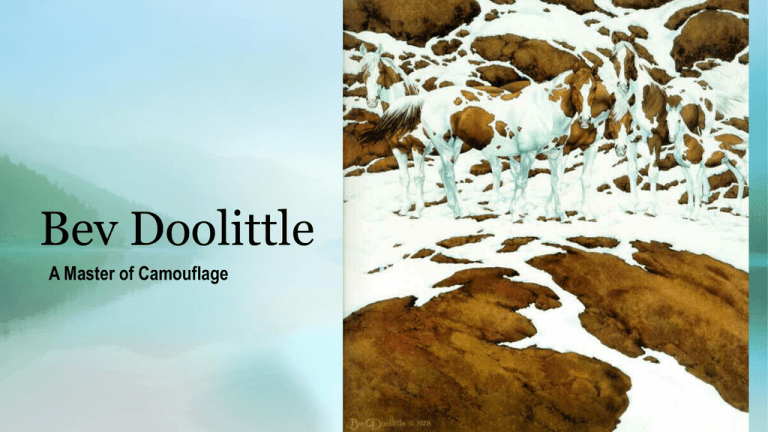Bev Doolittle A Master of Camouflage
advertisement

Bev Doolittle A Master of Camouflage Beverly Doolittle • Born in 1947 • Born in California • Graduated in Graphic Design in 1968 at Art Center College of Design in Los Angeles • Now she and her husband live in Utah • Doolittle spent 5 years as an Art Director at a Los Angeles, CA ad agency. • She and her husband decided to leave the graphic design world to be travelling artists. • She mostly paints in watercolor and acrylics, but once again the foundation of her skill is in drawing. • She loved painting and drawing horses. One project she worked on included horses in a forest. She didn’t like how the background looked so she painted rocks behind the horses and had an epiphany. • She loved how the rocks were able to camouflage the horse and played with that concept. It was very popular and she expanded the idea further and further. Building Nature and History into her Work Native Americans respected the buffalo. They used every part when they hunted them. This piece tells a story. The reflection of the rocks show the memory of the buffalo and the special connection the Native Americans have to nature. Recognizing the Magic in Nature Bev Doolittle is a master of guiding your eye. Where do you think the bear is? Hide and Seek. Finding the Faces • Combining her new found inspiration of camouflage in nature with her interest in the American Southwest she created amazing pieces • Doolittle is a visual storyteller • Details of her art can be seen in more than one way • She is one of the most collected artists in the United States In her words… “I love nature,” she says. “I try to look beyond the obvious and create unique, meaningful paintings depicting our Western wilderness and its inhabitants. I start with a concept and attempt to convey it through strong design coupled with detailed realism. I want people to think when they look at my paintings.” - Bev Doolittle Camouflage in Nature Camouflage keeps an animal hidden either from its predator or prey, either way it’s a tool nature uses for survival. Camouflage in Nature Camouflage can also trick predators. Like this caterpillar below. Or these moths. All in the line of survival… Hiding the Butterfly Core Elements of Art Covered: 1) Patterns 2) Line Weight 3) Repetition Step One: Write your name on your paper Step Two and Three: Draw the body of the butterfly. Note that any patterns you choose in the butterfly will be repeated outside of the butterfly. Steps Four through Six: Draw the wings of the butterfly to bleed off the page. Draw some butterfly wing shapes around the butterfly to start the camouflage process. Draw patterns inside the wings of the butterfly. Step Seven: The patterns you’ve drawn on the butterfly wings and body, should be repeated around the butterfly in the background. Step Eight: Trace over the pencil lines with black marker. Last Step: Color the butterfly. Repeat the same colors in the patterns in the butterfly as well as the patterns outside the butterfly. Practice pressing harder to outline part of the shape and lighter inside to create a difference in value.


